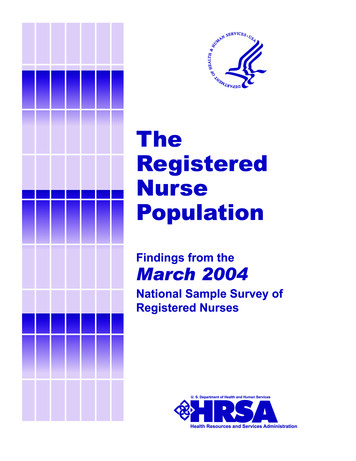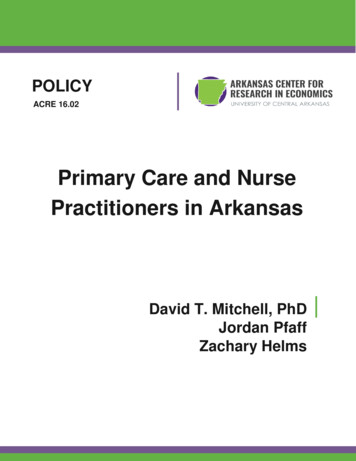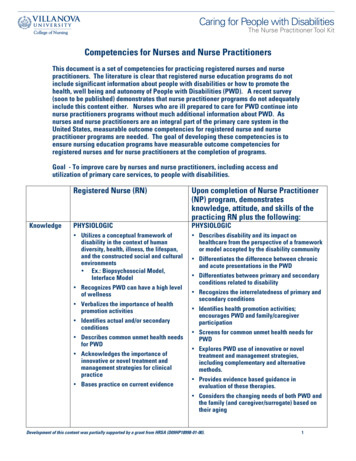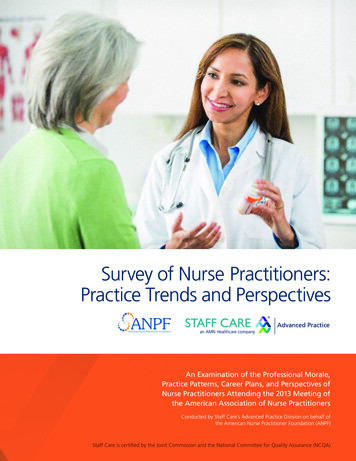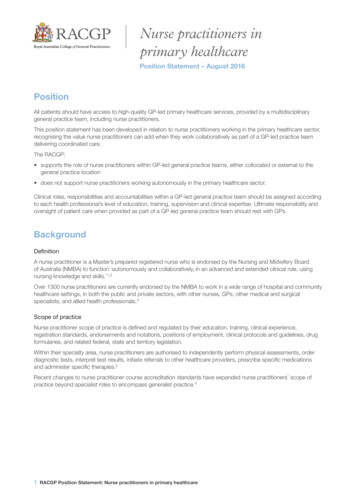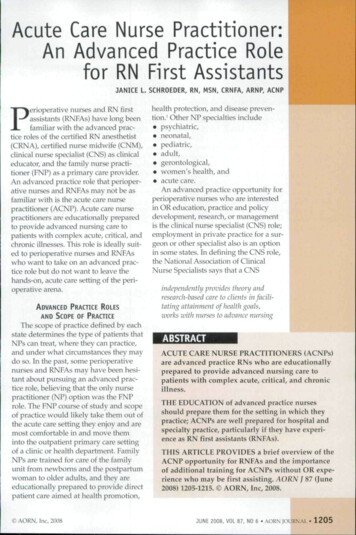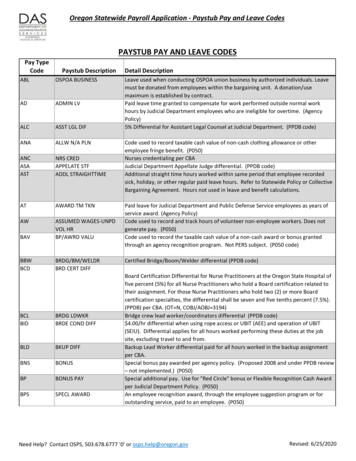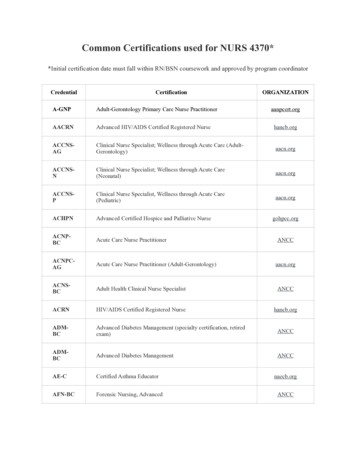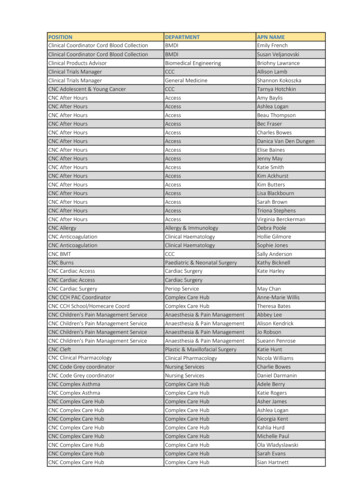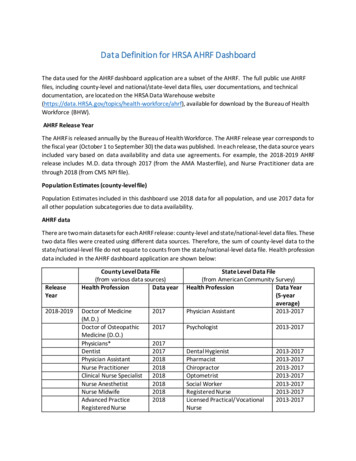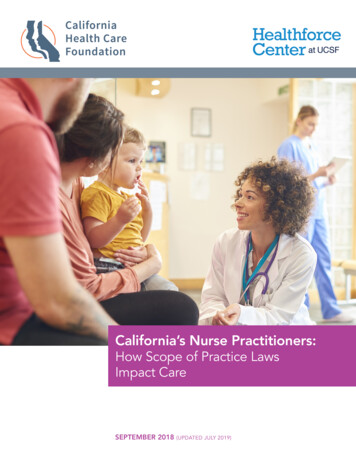
Transcription
California’s Nurse Practitioners:How Scope of Practice LawsImpact CareSEPTEMBER 2018 (UPDATED JULY 2019)
ContentsAbout the AuthorJoanne Spetz, PhD, is associate director ofresearch at Healthforce Center at UCSF. Sheis also a professor at the Philip R. Lee Institutefor Health Policy Studies, Department of Familyand Community Medicine, and the School ofNursing at UCSF.3 Overview of the ProfessionNurse Practitioner EducationPractice Oversight of Nurse Practitioners in CaliforniaOverview of Regulations in Other StatesRecent Changes in Other States7 Examining the Evidence for Practice Expansion:A Summary of ResearchAbout Healthforce Center at UCSFAccess to CareHealthforce Center at UCSF prepares healthcare organizations for success by combining adeep understanding of the issues facing theirworkforce with the leadership skills to driveprogress. They work with foundations, hospitals,delivery systems, organizations, and individualsto ensure more effective health care deliveryand to inform health care policy. Their effortsare focused in the core areas of leadership programs and workforce research.Quality of CareProductivity and Cost of Care13 AppendicesA. The Landscape of Nurse PractitionersB. O versight Requirements for Nurse Practitioners toAdvance to Full Practice Authority in Selected States21 EndnotesLearn more at healthforce.ucsf.edu.About the FoundationThe California Health Care Foundation isdedicated to advancing meaningful, measurable improvements in the way the health caredelivery system provides care to the people ofCalifornia, particularly those with low incomesand those whose needs are not well served bythe status quo. We work to ensure that peoplehave access to the care they need, when theyneed it, at a price they can afford.CHCF informs policymakers and industry leaders, invests in ideas and innovations, andconnects with changemakers to create a moreresponsive, patient-centered health care system.For more information, visit www.chcf.org.ABOUT THIS SERIESThis paper is one of a series that examines the scope ofpractice of selected California health professions. Theseries looks at professions discussed by the CaliforniaFuture Health Workforce Commission and its subcommittees and workgroups during spring and summer of2018. Each brief begins by describing the profession,including its legally permissible scope of work, andeducational requirements. The brief then outlines howCalifornia’s permissible scope of practice compareswith that of other states and provides a summary ofresearch studies on the impact of the profession’sscope of practice on access to care, care quality, andcosts. Finally, it summarizes demographic characteristics, practice settings, and geographic distribution.Visit www.futurehealthworkforce.org to learn more.California Health Care FoundationNote: This report was updated in July 2019 to provide moredetail about physician oversight requirements, particularly instates in which there is a transitional oversight period.2
California is 1 of 22 states that restricts nurse practitioners (NPs) by requiring that they practice andprescribe with physician oversight, and it is theonly western state with this requirement. A large bodyof research has linked such restrictions to lower supplyof NPs, poorer access to care for state residents, loweruse of primary care services, and greater rates of hospitalizations and emergency department visits. Althoughproponents of scope of practice restrictions argue thatphysician oversight is necessary to ensure quality of care,dozens of studies demonstrate both that the quality ofNP care is comparable to that of physician care, and thatthere is no difference in the quality of care when thereare no physician oversight requirements. Finally, severalstudies have found that full practice authority for NPs isassociated with lower costs of care.This paper describes the regulations that govern thescope of practice for NPs in California and in otherstates, and summarizes recent research on how theselaws impact care.Overview of theProfessionNurse practitioners (NPs) are registered nurses (RNs) whohave completed additional education to prepare them todeliver a broad range of services including the diagnosis and treatment of acute and chronic illnesses.1 Nursepractitioners trace their history to the late 1950s, whenRNs with clinical experience began to collaborate withphysicians in the delivery of primary care, particularly inrural areas. Nurse practitioners are one of four categories of advanced practice registered nurses (APRNs): NPs,certified nurse-midwives (CNMs), nurse anesthetists, andclinical nurse specialists.NPs provide a broad array of health services, includingtaking health histories and performing physical exams,diagnosing and treating acute and chronic illnesses,providing immunizations, performing procedures, ordering and interpreting lab tests and x-rays, coordinatingpatient care across multiple providers, providing healthA large body of research has linkedrestrictions on scope of practice tolower supply of NPs, poorer access tocare for state residents, lower use ofprimary care services, and greaterrates of hospitalizations andemergency department visits.How Scope of Practice Is Modifiedin CaliforniaScope of practice laws establish the legal frameworkthat controls the delivery of medical services. Thereach of these laws encompasses the full rangeof licensed health professionals — ranging fromphysicians and physical therapists to podiatrists anddental hygienists. Scope of practice laws governwhich services each category of licensed healthprofessional is allowed to provide and the settingsin which they may do so.With few exceptions, scope of practice statutesare set by state governments. State legislaturesconsider and pass the statutes that govern healthcare practices. Regulatory agencies, such as medicaland other health professions boards, implementthe statutes through the writing and enforcement ofrules and regulations.Such laws and regulations vary widely from stateto state. Some states allow individual professionsbroad latitude in the services they may provide,while others employ strict limits. The nature of thelimitations can either facilitate or hinder patients’ability to see a particular type of provider, which inturn influences health care costs, access, and quality.California’s Nurse Practitioners: How Scope of Practice Laws Impact Care3
education and counseling, and prescribing and managing medications and other therapies. The Veterans HealthAdministration reports that the roles of NPs are similar tothose of physicians in their system,2 and NPs are a keysource of care in community health centers and nursemanaged health centers nationwide.3 For a detailed lookat NP demographics and practice patterns in California,see Appendix A.Nurse Practitioner EducationThe first formal education program for nurse practitionerswas established at the University of Colorado in 1965with a focus on the delivery of primary care in rural communities.4 The program was codesigned by a physicianand a nurse. This and other early NP education programsconferred certificates, and many of the initial graduatesof these programs had received their RN education inhospital-based diploma programs. The California Boardof Registered Nursing (BRN) began certifying NPs in1985, and all states now certify or license NPs.Forty-five states and the District of Columbia requirecompletion of a master’s, postgraduate, or doctoratedegree from an accredited NP program, and then certification from a nationally recognized certifying body suchas the American Academy of Nurse Practitioners or theAmerican Nurses Credentialing Center.5 NP certificationin California can be obtained by successful completionof an NP education program that meets BRN standards,or by certification through a national organization whosestandards are equivalent to those of the BRN. There are23 approved NP programs in California. Since January2008, California requires that new NP applicants whohave not been qualified or certified as an NP in Californiaor any other state possess a master’s degree in nursing,a master’s degree in a clinical field related to nursing, ora graduate degree in nursing, and complete an NP program approved by the board. A nurse practitioner musthave BRN certification to practice in California, but certification from a national professional association is notrequired.Nurse practitioners can be prepared and certified inmany clinical areas, including family practice, pediatrics,women’s health, psychiatry, acute care, and community/public health. NP education covers a common range oftopics including physiology, various body systems, anddiagnosis and treatment of illnesses and conditions. ACalifornia Health Care Foundationrecent development in NP education is the establishment of the Doctor of Nursing Practice (DNP) degree,which is offered by an increasing number of nursingschools. However, the number of NPs educated in theseprograms is small thus far.Practice Oversight of NursePractitioners in CaliforniaIn California, NP practice is governed by the state nursepractice act.6 The Board of Registered Nursing has promulgated regulations that require the NP to work understandardized procedures for authorization to performoverlapping medical functions (CCR § 1485).7 This regulation requires that NPs work under collaboration with aphysician and adhere to standardized procedures developed through collaboration among administrators andhealth professionals, including physicians and surgeons.California NPs must obtain additional certification fromthe BRN to “furnish” (prescribe or order) drugs or devicesunder standardized procedures developed with thesupervising physician and surgeon.8As collaborators, physicians take legal responsibility forthe NP’s practice and are expected to determine theappropriate level of supervision, communicate regularlywith the NP, and oversee the NP’s practice and qualityof care. More than half of NPs in jobs with an NP titlein California report that they are “always” (39.7%) or“almost always” (16.4%) involved in the development orrevision of standardized procedures. Nearly 8% of NPsreport never having a voice in the development of standardized procedures.9There are no rules regarding proximity of the physicianto the NP, and thus a physician can provide supervisionremotely — even from hundreds of miles away. In 2017,72.6% of California NPs reported that their collaboratingphysician practiced in the same location they did, while9.8% of NPs indicated that their collaborating physicianwas at another practice or system.10 There are no dataregarding the share of California physicians who formallycollaborate with one or more NPs or the share who arewilling to collaborate with NPs.One specific area of regulation concerns the prescribingof buprenorphine for the treatment of opioid use disorder in office settings. Since 2002, buprenorphine can beprescribed in office-based care settings by a provider4
who has a waiver under the Drug Addiction TreatmentAct (DATA) of 2000.11 This prescribing was limited to physicians until passage of the Comprehensive Addictionand Recovery Act (CARA) in 2016, which allows NPs andphysician assistants (PAs) to obtain waivers.12,13 CARA stipulates that if a state requires physician oversight of NP/PA prescribing, the physician must have a DATA waiverto prescribe buprenorphine or must meet other specificqualifications.14 These restrictions impact the percentageof NPs engaged in treatment for opioid use disorder.15Overview of Regulations inOther StatesState regulations regarding NP scope of practice varywidely. In an effort to encourage greater consistencyacross states, the National Council of State Boards ofNursing has developed a Model Act, which providesconsensus-based recommendations regarding how anideal nurse practice act should be written.16 The ModelAct explicitly defines the scope of practice of APRNsto include conducting assessments; ordering and interpreting diagnostic procedures; establishing diagnoses;prescribing, ordering, administering, dispensing, andfurnishing therapeutic measures; delegating to assistivepersonnel; and consulting with other disciplines and providing referrals. The Model Act recommends that APRNsbe licensed independent practitioners.In 14 states and the District of Columbia, NPs canpractice and prescribe without physician collaborationor supervision immediately upon licensure, and in 14additional states an NP can practice without physicianoversight after a transitional period during which supervision by a physician or another NP is required. Statesthat require physician collaboration or supervision of NPshave a variety of specific regulations related to this supervision, described below and summarized in Table 1 (seepage 6).17,18Formal agreements and chart review. Twenty-twostates require that an NP be supervised or have a written collaboration agreement with a physician in order topractice and prescribe medications, regardless of howlong the NP has been in practice. In some states, a physician must review a specific share of patient records, andother states specify that chart review must occur but donot specify what share.Physician proximity. Some states specify the maximumdistance permitted between the NP and physician; somestates specify the number of miles, such as Mississippi(75 miles), and some states require a certain proximityfor a specified amount of time. For example, in Alabama,the physician must be on-site for at least 10% of the NP’shours.Consultation frequency. Some states specify the frequency of consultation between an NP and physician,which can range from every 30 days (Tennessee) to annually (Ohio). Other states require an agreement regardingfrequency of collaboration but do not specify that frequency. The frequency with which collaborative practiceagreements must be reviewed is specified by somestates.Supervision rules. In many states there are limits to thenumber of NPs a physician can supervise. Several statespermit NPs to practice without supervision after a transitional period. These states can specify the number ofsupervised hours required, number of months required,or both. Some of these states allow the supervision to beprovided by another NP.California’s Nurse Practitioners: How Scope of Practice Laws Impact Care5
Table 1. Selected Features of State Nurse Practitioner Scope of PracticeNUMBER OF STATES / DETAILSFull practice authority to practiceand prescribe without physiciancollaboration upon licensure14 Alaska, Arizona, Hawaii, Idaho, Iowa, Montana, New Hampshire, New Mexico,North Dakota, Oregon, Rhode Island, Utah, Washington, and Wyoming, plusthe District of Columbia.Transitional supervision period14 Colorado, Connecticut, Delaware, Illinois, Kentucky, Maine, Maryland,Minnesota, Nebraska, Nevada, South Dakota, Vermont, Virginia, andWest Virginia (See Appendix B for detailed requirements for each state.)Maximum number of NPs that can besupervised by a physician8 Alabama: 3 FTEs per weekFlorida: no more than 4 satellite offices for primary care,stricter limits for specialtyGeorgia: 8 total but only 4 “at any given time”New York: 4 if not at same physical locationOhio: 5 prescribing NPsOklahoma: 2 FTE NPs or 4 NPs totalTexas: 7 FTEsMaximum distance between physicianand NP4 Alabama: physician on-site 10% of NP hoursMississippi: 75 milesMissouri: 30 miles; 50 miles in shortage area; same site for first monthSouth Carolina: “near proximity”Physician review of charts required7 Alabama, Georgia, Mississippi: 10% of charts per yearMissouri: every 2 weeksNew York, Virginia: frequency not specifiedTennessee: 20% of chart notes within 30 daysFrequency of consultation with MDspecified in law8 Alabama: 4 times per yearGeorgia: quarterlyIllinois: monthlyMississippi: quarterlyNorth Carolina: every 6 months but monthly for first 6 months of collaborationOhio: annually with a chart reviewTennessee: on-site visit by physician every 30 daysTexas: monthly for first 3 years, then 4 times per year with monthlytelecommunicationNote: Additional states may have similar regulations that were not identified.Sources: State Law Chart: Nurse Practitioner Practice Authority, American Medical Association, 2017, www.ama-assn.org (PDF); and State-by-State Guide to LawsRegarding Nurse Practitioner Prescriptive Authority and Physician Practice, National Nurse-Led Care Consortium, September 2017, nurseledcare.org (PDF).California Health Care Foundation6
Recent Changes in Other StatesSince 2010, 21 states have enacted regulatory changesthat have provided NPs with a greater degree of practice authority, including 9 states that now allow NPs topractice without physician oversight. These changes areconsistent with recommendations from leading authorities, including the National Academy of Medicine andthe National Governors Association, which have statedthat NPs be allowed to practice without physician oversight.19, 20 In addition, the US Federal Trade Commission(FTC) issued a policy paper in 2014, Competition and theRegulation of Advanced Practice Nurses, which advisedpolicymakers that “APRN scope of practice limitationsshould be narrowly tailored to address well-foundedhealth and safety concerns, and should not be morerestrictive than patient protection requires.” The FTC policy paper also noted that the FTC has “consistently urgedstate legislators to avoid imposing restrictions on APRNscope of practice unless those restrictions are necessaryto address well-founded patient safety concerns.”21States have gradually granted NPs authority to practice autonomously. Between 2011 and 2019, NPs weregranted full authority to practice and prescribe withoutphysician oversight in nine states: North Dakota (2011),Vermont (2011), Nevada (2013), Rhode Island (2013),Connecticut (2014), Minnesota (2014), Maryland (2015),Nebraska (2015), South Dakota (2016), West Virginia(2017), and Virginia (2019). In addition, incrementalchanges were made to provide NPs with greater practice authority in Alabama, Delaware, Florida, Illinois,Kentucky, Michigan, New York, Ohio, Texas, Utah, andWest Virginia.22 Nine of the states that have recentlyestablished full practice authority for NPs require a transitional period of oversight by a physician or NP; theexceptions are North Dakota and Rhode Island.Prescribing authority, one major element of NP scope ofpractice, has changed over the years. In 2006, Georgiabecame the last state to grant NPs prescriptive authority,23 and in 2016, Florida became the last state toauthorize NPs to prescribe controlled substances.24Today, NPs hold prescription privileges in all 50 statesand the District of Columbia. NPs may prescribe controlled substances, including Schedule III substances inevery state and Schedule II substances, such as oxycodone, methadone, and fentanyl, in all but 7 states.25A similar trend toward expanded practice authority is visible at the federal level. In 2016, the US Department ofVeterans Affairs announced new regulations permittingfull practice authority for the nearly 6,000 APRNs in itsworkforce, allowing them “to practice to the full extent oftheir education, training, and certification, regardless ofState restrictions that limit such full practice authority.”26Examining the Evidencefor Practice Expansion:A Summary of ResearchNPs and physicians both agree that it’s valuable for NPsto have some association with physicians.27 However,daily autonomy of NPs and their ability to fully use theirskills is diminished when state regulations require physician oversight.28 In a 2017 survey, 60.2% of CaliforniaNPs reported “always fully using their NP skills,” and anadditional 21% were almost always doing so. California’srelatively restrictive scope of practice regulations may bea factor for the 19% of NPs who are not at least “almostalways” fully using their skills.29 A large body of researchhas examined the relationship between scope of practiceregulations for NPs and access to care, quality of care,and health care costs (see Tables 2, 3, and 4).Access to CarePhysician supply will meet less than half of demand forprimary care in 2030, but this gap can be filled by projected growth in nurse practitioner and physician assistantsupply.30 Many policy leaders point to the elimination ofunnecessary barriers to nurse practitioners’ practice as ameans to address primary care shortfalls, particularly inrural and underserved areas.31,32Rural and vulnerable populations. Numerous studieshave found that state regulations requiring physicianoversight of NPs and other restrictions on NP practiceare associated with decreased access to care for patients,particularly in rural regions and for Medicaid enrollees. In2016, a systematic review of the impact of state NP scopeof practice regulations on health care delivery determined that “[s]tates granting NPs greater SOP authoritytend to exhibit (a) an increase in the number and growthof NPs through higher APRN educational enrollmentCalifornia’s Nurse Practitioners: How Scope of Practice Laws Impact Care7
and migration and (b) greater provision of primary careby NPs and expanded health care utilization, especiallyamong rural and vulnerable populations.”33Removing barriers to mental health care. The largeprojected shortfall of psychiatrists in California can belessened by the use of psychiatric/mental health NPsbecause both can prescribe medications.34,35 Two papershave reported that scope of practice regulations createbarriers to the use of psychiatric/mental health NPs inpublic health systems in California, in part because publichealth directors find the regulations confusing and havedifficulty finding psychiatrists who are willing to superviseNPs.36,37See Table 2 for a compilation of recent research findingson access to care.Table 2. Access-to-Care Research Findings, continuedFull practice authoritySOURCE States in which NPs have full practice authority have alarger supply of NPs.P. B. Reagan and P. J. Salsberry, “The Effects of State-Level Scopeof-Practice Regulations on the Number and Growth of NursePractitioners,” Nursing Outlook 6, no. 1 (2013), 392–99. NPs in states with full practice and prescribingauthority are more likely to practice in primary care,in rural regions, and with Medicaid patients. Theyalso are more likely to practice in areas with lowersocioeconomic and health status.P. I. Buerhaus et al., “Practice Characteristics of Primary CareNurse Practitioners and Physicians,” Nursing Outlook 63, no. 2(Mar./Apr. 2015): 144–53, doi:10.1016/j.outlook.2014.08.008; andM. A. Davis et al., “Supply of Healthcare Providers in Relation toCounty Socioeconomic and Health Status,” Journal of GeneralInternal Medicine 33, no. 4 (2018): 412–14. NPs are more likely to work in primary care in stateswith full scope of practice, and also are more likelyto provide primary care if the state also reimbursesNPs at 100% of the physician Medicaid fee-for-servicerate.H. Barnes et al., “Effects of Regulation and Payment Policies onNurse Practitioners’ Clinical Practices,” Medical Care Research andReview 74, no. 4 (2016): 431–51, doi:10.1177/1077558716649109. Removing scope of practice restrictions couldmodestly expand the capacity of the primary careworkforce in the short run.J. A. Graves et al., “Role of Geography and Nurse Practitioner Scopeof-Practice in Efforts to Expand Primary Care System Capacity:Health Reform and the Primary Care Workforce,” Medical Care 54,no. 1 (Jan. 2016): 81–89, doi:10.1097/MLR.0000000000000454. The share of patients for whom NPs billed Medicareindependently grew more rapidly when NPs had fullpractice authority.Y.-F. Kuo et al., “States with the Least Restrictive RegulationsExperienced the Largest Increase in Patients Seen by NursePractitioners,” Health Affairs 32, no. 7 (2013): 1236–43, doi:10.1377/hlthaff.2013.0072. There are fewer avoidable hospitalizations andhospital readmissions in states in which NPs have fullpractice authority.G. Oliver et al., “Impact of Nurse Practitioners on Health Outcomesof Medicare and Medicaid Patients,” Nursing Outlook 62, no. 6(2014): 440–47. The NP supply to health professional shortage areasrose more rapidly between 2009 and 2013 in statesthat did not require physician oversight.Y. Xue et al., “Full Scope-of-Practice Regulation Is Associated withHigher Supply of Nurse Practitioners in Rural and Primary Care HealthProfessional Shortage Counties,” Journal of Nursing Regulation 8, no.4 (2018): 5–13. Access to primary care is greater in states in whichphysician oversight is not required.K. Stange, “How Does Provider Supply and Regulation InfluenceHealth Care Markets? Evidence from Nurse Practitioners andPhysician Assistants,” Journal of Health Economics 33 (2014): 1– 27. Patients have shorter travel times to their closestprimary care provider in states that do not requirephysician oversight of NPs.D. F. Neff et al., “The Impact of Nurse Practitioner Regulations onPopulation Access to Care,” Nursing Outlook (2018), online aheadof print. The frequency of routine checkups increases andemergency room use for patients with ambulatorycare–sensitive conditions declines when states eliminate regulations requiring physician oversight of NPs.J. Traczynski and V. Udalova, “Nurse Practitioner Independence,Health Care Utilization, and Health Outcomes,” Journal of HealthEconomics 58 (2018): 90–109.California Health Care Foundation8
Table 2. Access-to-Care Research Findings, continuedRelaxing restrictions on SOPSOURCE States that relaxed restrictions on SOP experiencedgrowth in the number of routine checkups, improvements in quality-of-care measures, and decreases inemergency room use by patients with ambulatorycare–sensitive conditions.Impact of State Scope of Practice Laws and Other Factors onthe Practice and Supply of Primary Care Nurse Practitioners, USDepartment of Health and Human Services, November 2015. Relaxation of NP scope of practice regulations isassociated with retail clinic growth, which offerspatients a convenient, low-cost source of care forcommon acute conditions such as urinary tract infection and bronchitis.J. M. B. Carthon et al., “Growth in Retail-Based Clinics FollowingNurse Practitioner Scope of Practice Reform,” Nursing Outlook 65,no. 2 (Mar.–Apr. 2016): 195–201, doi:10.1016/j.outlook.2016.11.001.SOP regulations create barriers to care Scope of practice regulations create barriers to theuse of psychiatric/mental health NPs in public healthsystems in California, in part because public healthdirectors find the regulations confusing and havedifficulty finding psychiatrists who are willing tosupervise NPs.S. A. Chapman et al., “Utilization and Economic Contributionof Psychiatric Mental Health Nurse Practitioners in PublicBehavioral Health Services,” American Journal of PreventiveMedicine 54, no. 6, suppl. 3 (June 2018): S243–49; and B. Phoenix,M. Hurt, and S. A. Chapman, “Experience of Psychiatric MentalHealth Nurse Practitioners in Public Mental Health,” NursingAdministration Quarterly 40, no. 3 (July–Sept. 2016): 212–24,doi:10.1097/NAQ.0000000000000171.Quality of CareSome proponents of restrictive scope of practice regulations for NPs cite concerns about the quality of care thatmight be provided by NPs relative to physicians, sinceNP education is shorter and more narrowly focused onprimary care and a subset of specialty fields. However,multiple systematic reviews of the literature concludethat NPs provide care of comparable quality as physicians, even when NPs practice without physicianoversight.38 Findings were similar for studies that lookedat primary care in general and for studies that lookedat specific aspects of patient care, such as prescribing,chronic disease management, and ordering diagnostictests. Researchers looking at long-term care settings andat rural and community health centers came up with similar findings.More tests? Two studies, published in 1999 and 2015,report that NPs order more tests and generate morespecialty referrals than physicians. Both studies, however, have significant shortcomings including smallsample size, possibly misattribution of who orderedtests, insignificant differences, and subanalyses with contradictory findings.39 – 41 As mentioned, other studies havefound that NPs do not order more tests or produce morespecialty referrals than physicians.Surveys of nurse practitioners. Nurse practitionersreport that restrictive scope of practice laws negativelyimpact the quality of care they are able to provide. In theBRN survey of California NPs, 11.3% of those employedin NP positions say scope of practice restrictions are amajor barrier to their ability to provide high-quality care,and 29.1% say scope of practice restrictions are a minorbarrier. Similarly, an exploratory survey found that NPsperceived that requirements for physician oversightimpacted their practice and may jeopardize patientsafety.42See Table 3 on page 10 for a detailed list of research findings on quality of care.California’s Nurse Practitioners: How Scope of Practice Laws Impact Care9
Table 3. Quality-of-Care Research Findings, continuedGeneralSOURCE NPs provide primary care of similar quality as physiciansand, in some aspects, NP quality of care may be higher.R. P. Newhouse et al., "Advanced Practice Nurse Outcomes1990-2008: A Systematic Review," Nursing Economics 29, no. 5(Sept.–Oct. 2011): 230–50. Eleven quality and patient outcomes measures for NPs arecomparable to or better than those achieved by physicians.J. Stanik-Hutt et al., "The Quality and Effectiveness ofCare Provided by Nurse Practitioners," Journal for NursePractitioners 9, no. 8 (2013): 492–500. Patients with NPs as usual and supplemental providers hadmore primary care visits than patients with physician-onlycare. No differences were seen for hospitalizations orunmet need.C. M. Everett, P. Morgan, and G. L. Jackson, "Primary CarePhysician Assistant
or any other state possess a master's degree in nursing, a master's degree in a clinical field related to nursing, or a graduate degree in nursing, and complete an NP pro-gram approved by the board. A nurse practitioner must have BRN certification to practice in California, but cer-tification from a national professional association is not
